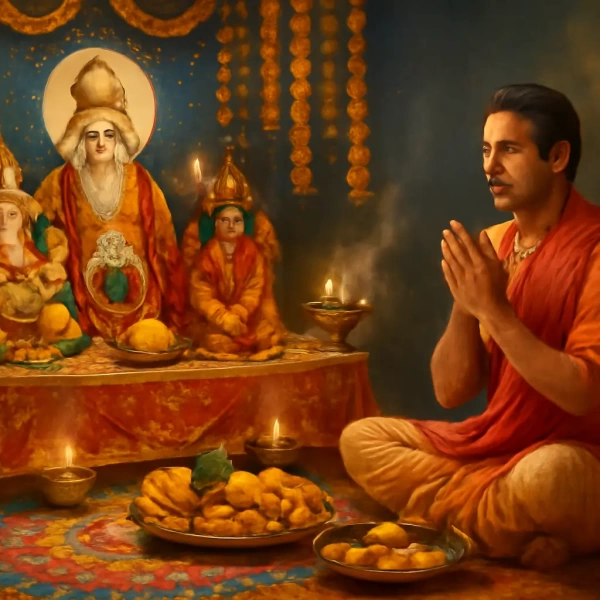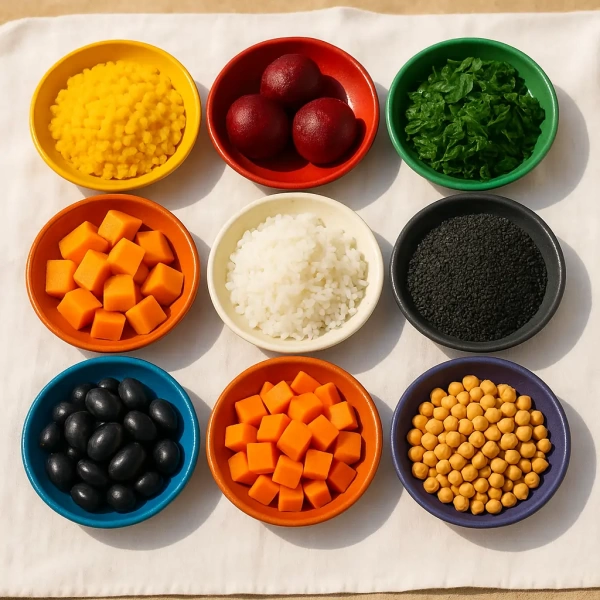
Introduction
In Vedic astrology, the Navagrahas (nine celestial influencers) are the key to understanding our life journey. Everything in life – from health and profession to relationships and spirituality – is influenced by planetary positions. When these planets become imbalanced or afflicted in someone’s horoscope, they introduce problems, tensions, or delays.
To appease such planetary energies and harmonize them, believers conduct a very powerful ritual called Navagraha Shanti Puja.
What is Navagraha Shanti Puja?
● Navagraha is the Sanskrit term. “Nava” = nine and “Graha” = planet.
● The word Shanti refers to peace or tranquility.
● Thus, Navagraha Shanti Puja is a prayer that we do to remain peaceful with the nine planets.
These nine planets are believed to be very powerful and have dominance over our lives positively or negatively. Their names and their significance are mentioned below:
1. Surya (Sun) – Gives energy, strength, and leadership
2. Chandra. (Moon) – Influences our mind, emotions, and tranquility
3. Mangal. (Mars) – Gives courage, audacity, and action
4. Budh. (Mercury) – Makes us think, talk, and convey
5. Guru. (Jupiter) – Gives knowledge, expansion, and benediction
6. Shukra. (Venus) – Gave love, comfort, and beauty
7. Shani. (Saturn) – Gives discipline, diligence, and education
8. Rahu. – A shadow planet that induces sudden change or bewilderment 9. Ketu. – The other shadow planet, which gives spiritual teachings and detachment
Why Do People Do Navagraha Shanti Puja?
The puja is typically done if one is going through a difficult phase due to the influence of one or more planets. Additionally, at times, planets are ill-placed in your horoscope. This might result in:
People often turn to Navagraha Shanti Puja when facing persistent life struggles such as repeated illness or chronic health concerns. It is also advised in cases of family disagreements, academic or career setbacks, or marriage and job delays. Those experiencing unwanted depressive thoughts, intense fears, or sudden misfortunes in important matters may also benefit from this powerful ritual.
If we perform Navagraha Shanti Puja sincerely, it will resolve such problems by soothing the planets.
Who Must Do Navagraha Shanti Puja?
Astrologers generally suggest this puja to those who are suffering from:
● Shani Dosha (Saturn affliction)
● Rahu or Ketu Mahadasha
● Manglik Dosha (Mars affliction)
● Kaal Sarp Dosha

This puja is also helpful before significant new starts, such as marriages, business startups, or house warming ceremonies (Griha Pravesh).
When Should We Perform Navagraha Shanti Puja?
● Do the Navagraha Shanti Puja best after an astrologer advises it upon reading your horoscope.
● Several people also do it before initiating something new, such as:
1) A wedding
2) A new business
3) New house moving in (Graha Pravesh)
Furthermore, festive days like Saturday or Amavasya (New Moon Day) are good to perform this puja.
● Festive days like Saturday or Amavasya (New Moon Day) are good to perform this puja.
How is Navagraha Shanti Puja Performed?
The puja may be done traditionally by a seasoned Vedic priest at a temple, home, or even online.
Navagraha Puja Vidhi (Procedure)
Sample Sankalpa
A Sankalpa is the intention or promise that an individual makes at the start of a puja, and it should be chanted to determine the intention behind the ritual. A sample Sankalpa is as follows:
Sanskrit:
“सर्वग्रह दोष निवारणार्थे, श्रीग्रह शक्तिवर्धनं च, श्रीनाम सोमोत्तमे, (Your Name) गोत्रे, श्रीनमः”
English:
“For the eradication of all planetary maladies and the uplift of divine planetary power, I, (Your Name), of (Your Gotra), make this prayer with dedication.”
You can modify this Sankalpa according to your intentions and the motive behind your Navagraha Shanti Puja.
1. Ganesh Pūjā – To remove obstacles and invoke auspiciousness.
2. Kalash Sthāpanā – Installation of the sacred pot symbolizing divine presence.
3. Pavitrāraṇam – Purification of the space and self.
4. Graha Āvāhan – Invocation of each of the nine planets (grahas) with:
• One mantra,
• Akṣat (uncooked rice), and
• Pushpa (flower).
5. Japa – Chanting 108 malas (or minimum 1 mala) of mantras per graha, based on dosha severity.
6. Graha Sūkta Pātha – Recital of Vedic hymns dedicated to each planet.
7. Navagraha Homa – Fire offering using 9 specific types of samidh (sacred wood) for each graha.
8. Pūrṇāhuti – Final, complete offering to signify conclusion of the havan.
9. Navagraha Ārati – Ceremonial waving of lights and singing in praise of the planets.
10. Tarpana – Offering water with mantras for appeasement of the grahas and ancestors.
11. Brahmaṇa Bhojana – Feeding of learned priests to transfer the puja’s spiritual merits.
Abhiṣek/Dravya List for Every Graha

Symbolizing its unique energy:
- Surya (Sun): Raw milk + red flowers
- Chandra (Moon): Rice + white cloth
- Mangala (Mars): Pure water + red sandalwood powder
- Budha (Mercury): Green gram + honey
- Guru (Jupiter): Yellow rice + turmeric powder
- Shukra (Venus): Curds (yogurt) + white flowers
- Shani (Saturn): Sesame oil + black sesame seeds
- Rahu (North Node of the Moon): Coconut + mustard oil
- Ketu (South Node of the Moon): Ghee + dried fruits
Beej Mantra of Navagrahas
1. Surya (Sun): Om Hraam Hreem Hraum Sah Suryaya Namah
2. Chandra (Moon): Om Shraam Shreem Shraum Sah Chandraya Namah 3. Mangala (Mars): Om Kraam Kreem Kraum Sah Bhaumaya Namah
4. Budha (Mercury): Om Braam Breem Braum Sah Budhaya Namah
5. Guru (Jupiter): Om Graam Greem Graum Sah Gurave Namah
6. Shukra (Venus): Om Draam Dreem Draum Sah Shukraya Namah
7. Shani (Saturn): Om Praam Preem Praum Sah Shanaishcharaya Namah 8. Rahu (North Node of the Moon): Om Bhraam Bhreem Bhraum Sah Rahave Namah 9. Ketu (South Node of the Moon): Om Sraam Sreem Sraum Sah Ketave Namah
Mantra Counts and Dashāṁś-Havan Details in Navagraha Shanti Puja
In this segment, you’ll understand how many chants and offerings are done per planet. In a Navagraha Shanti Puja, the Dashāṁś-havan number is usually 10% of the overall japa number. For instance, if you chant 10,000 mantras for the Sun, then the Dashāṁś-havan would comprise around 1,000 offerings (ahutis), and 11 × 108 mantras (or 1,188 ahutis) being the most widely practiced number by priests.
Mantra-count guidelines:
- 7000 mantras for Saturn and Jupiter
- 10,000 mantras for Sun, Moon, Mars, Mercury, and Venus
- 18,000 mantras for Rahu
- 17,000 Ketu mantras
Alternatively, a shorter communal option would be 11 malas × 9 for the nine planets.
The number of mantras may vary based on the intensity of the individual’s horoscope and the package chosen by the priest. More intense doshas could involve higher numbers of mantras.
Post-Puja Regimen for Navagraha Shanti

To increase the efficiency of Navagraha Shanti Puja, practice the following post-puja routines:
Daily Practices:
- 1 Mala Graha Mantra: Recite the beej mantra of the targeted planet or a general mantra on a daily basis.
- Sesame Oil Lamp: Place a sesame oil lamp on every Saturday, particularly for Shani and Rahu/Ketu.
- Yellow-Turmeric Water for Surya: Offer yellow-turmeric water to Surya in the early morning.
Charity Practices:
- Black Cloth (Saturday): Give black cloth for Shani.
- Wheat (Wednesday): Offer wheat in Budha’s name.
- White Sweets (Monday): Offer white sweets in Chandra’s name.
Discipline Period:
40-Day Routine: Take this regimen for 40 days after puja, keeping to a sattvic diet (no non-veg, alcohol, or intoxicants). This seals the puja’s effects.
Taking these steps will ensure long-term benefits and bring your energies in tune with the planets.
Advantages of Navagraha Shanti Puja
When this puja is performed with sincerity, the following advantages occur: ● Erases doshas of the planets and their harmful effects
● Makes one healthier, wealthier, and generally well off
● Restores peace of mind and confidence
● Enhances spiritual growth and understanding
● Enhances personal and professional good luck
● Brings family life and relationship harmony
Price of Navagraha Shanti Puja
The price of this puja will be different according to the place, the experience of a priest, and the service provider.
Approximate Price Range: ₹1,100 to ₹11,000
Booking Navagraha Puja Online
In recent times, due to technological progress, you can book Navagraha Shanti Puja online through genuine spiritual portals. They will generally have live video streaming or video captures, as well as the prasad delivery.
Recommended Online Websites to Book:
- SmartPuja – Original priests, live-streamed pujas
- Price: ₹4,100 (including video & prasād)
- Price: ₹4,100 (including video & prasād)
- PujaNPujari – Tailored puja packages
- Price: ₹5,000 – ₹7,000 (depends on the puja package)
- Price: ₹5,000 – ₹7,000 (depends on the puja package)
- AstroVed – Vedic rituals with experienced astrologers
- Price: ₹6,900 (includes 9-graha homa)
- Price: ₹6,900 (includes 9-graha homa)
- ClickPuja – Web temple offerings
- Price: ₹2,500 – ₹4,000 (depending on the service)
- Price: ₹2,500 – ₹4,000 (depending on the service)
- TempleYatri – Real and cost-effective rituals
- Price: ₹3,000 – ₹8,000 (based on location and specific rituals)
- Price: ₹3,000 – ₹8,000 (based on location and specific rituals)
Temple vs. Online Cost Clarity:
- Kashi Temple Priest (Offline) – ₹11,000
- Online Providers can vary, but expect additional costs:
- Courier charges: ₹200–₹500
- GST: Typically 18%
- Priest Dakṣiṇā (Tip): 15-25% extra depending on the platform or temple.
- Courier charges: ₹200–₹500
Result Timeline Realism:
- Subtle Relief: Many people experience mental peace or relief within 21 days after the puja.
- Material Shifts: More tangible changes, like improvements in life circumstances, can take around 1 planetary transit (usually 3–12 months).
- Note: Results depend on individual astrological charts and the severity of doshas. Be patient, as changes may take time.
Risk & Verification Note:
Avoid Group Puja Upsells: Watch out for sites providing “group pujas” where a large number of people are included in a single session. Always demand live links, puja reports, temple receipts, and the priest’s name/mantra list to verify authenticity.
Astrological Triggers:
Navagraha Remedy Combinations:
- Sade-sāti + Rahu/Ketu Mahādaśā overlap
- Kal-Sarp Yog
- Weak Lagna Lord aspected by Saturn/Rahu
- Pre-marriage Muhurta when malefics are placed in Kendras.
Regional Variants:
South-Indian Tradition: Usually employs sesame oil, deepam, and navadhānya mandala.
North-Indian Tradition: Incorporates the placing of nine copper coins and doing the graha-sūkta patha.
Being aware of these local variations enables tourists to know what to anticipate.
Scriptural Anchors:
Quote Bṛhat Parāśara Horā Śāstra (23.1-17) or Navagraha Kalpa-druma to include authority and SEO value to the puja customs.
FAQs
Q1. Can I club Navagraha with Rudrābhiṣek?
Yes, combining these rituals is effective as Shiva controls the shadow planets and enhances the results.
Q2. Can pregnant women attend?
Yes, but avoid certain rituals like fasting or heavy physical involvement. Consult the priest for specific guidance.
Q3. Is a gemstone compulsory after the puja?
No, it’s not compulsory, but an astrologer may recommend one based on your chart.
Q4.What if I miss a japa count?
You can make up for it by completing the missed count on another day.
Final Thoughts
Navagraha Shanti Puja isn’t a ritual per se—it is an internal balancing act that harmonizes cosmic forces and your inner universe. Honoring the planets, you balance life’s disarray and bring in clarity, peace, and constructive change.
So, whether you are confronted by obstinate problems or waiting for a turning point in life, this puja can help you navigate through the gods’ grace.

